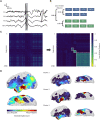Identifying sources of human interictal discharges with travelling wave and white matter propagation
- PMID: 37527460
- PMCID: PMC11046055
- DOI: 10.1093/brain/awad259
Identifying sources of human interictal discharges with travelling wave and white matter propagation
Abstract
Interictal epileptiform discharges have been shown to propagate from focal epileptogenic sources as travelling waves or through more rapid white matter conduction. We hypothesize that both modes of propagation are necessary to explain interictal discharge timing delays. We propose a method that, for the first time, incorporates both propagation modes to identify unique potential sources of interictal activity. We retrospectively analysed 38 focal epilepsy patients who underwent intracranial EEG recordings and diffusion-weighted imaging for epilepsy surgery evaluation. Interictal discharges were detected and localized to the most likely source based on relative delays in time of arrival across electrodes, incorporating travelling waves and white matter propagation. We assessed the influence of white matter propagation on distance of spread, timing and clinical interpretation of interictal activity. To evaluate accuracy, we compared our source localization results to earliest spiking regions to predict seizure outcomes. White matter propagation helps to explain the timing delays observed in interictal discharge sequences, underlying rapid and distant propagation. Sources identified based on differences in time of receipt of interictal discharges are often distinct from the leading electrode location. Receipt of activity propagating rapidly via white matter can occur earlier than more local activity propagating via slower cortical travelling waves. In our cohort, our source localization approach was more accurate in predicting seizure outcomes than the leading electrode location. Inclusion of white matter in addition to travelling wave propagation in our model of discharge spread did not improve overall accuracy but allowed for identification of unique and at times distant potential sources of activity, particularly in patients with persistent postoperative seizures. Since distant white matter propagation can occur more rapidly than local travelling wave propagation, combined modes of propagation within an interictal discharge sequence can decouple the commonly assumed relationship between spike timing and distance from the source. Our findings thus highlight the clinical importance of recognizing the presence of dual modes of propagation during interictal discharges, as this may be a cause of clinical mislocalization.
Keywords: epilepsy; iEEG; interictal epileptiform discharges; source localization; white matter.
Published by Oxford University Press on behalf of the Guarantors of Brain 2023.
Conflict of interest statement
The authors report no competing interests.
Figures





References
-
- Alarcon G, Garcia Seoane JJ, Binnie CD, et al. Origin and propagation of interictal discharges in the acute electrocorticogram. Implications for pathophysiology and surgical treatment of temporal lobe epilepsy. Brain. 1997;120(Pt 12):2259–2282. - PubMed
-
- de Curtis M, Jefferys JGR, Avoli M. Interictal epileptiform discharges in partial epilepsy: Complex neurobiological mechanisms based on experimental and clinical evidence. In: Noebels JL, Avoli M, Rogawski MA, Olsen RW, Delgado-Escueta AV, eds. Jasper's basic mechanisms of the epilepsies, 4th ed. National Center for Biotechnology Information; 2012:213-227. - PubMed
-
- de Curtis M, Avanzini G. Interictal spikes in focal epileptogenesis. Prog Neurobiol. 2001;63:541–567. - PubMed
-
- Rosenow F, Luders H. Presurgical evaluation of epilepsy. Brain. 2001;124(Pt 9):1683–1700. - PubMed
-
- Zijlmans M, Zweiphenning W, van Klink N. Changing concepts in presurgical assessment for epilepsy surgery. Nat Rev Neurol. 2019;15:594–606. - PubMed

